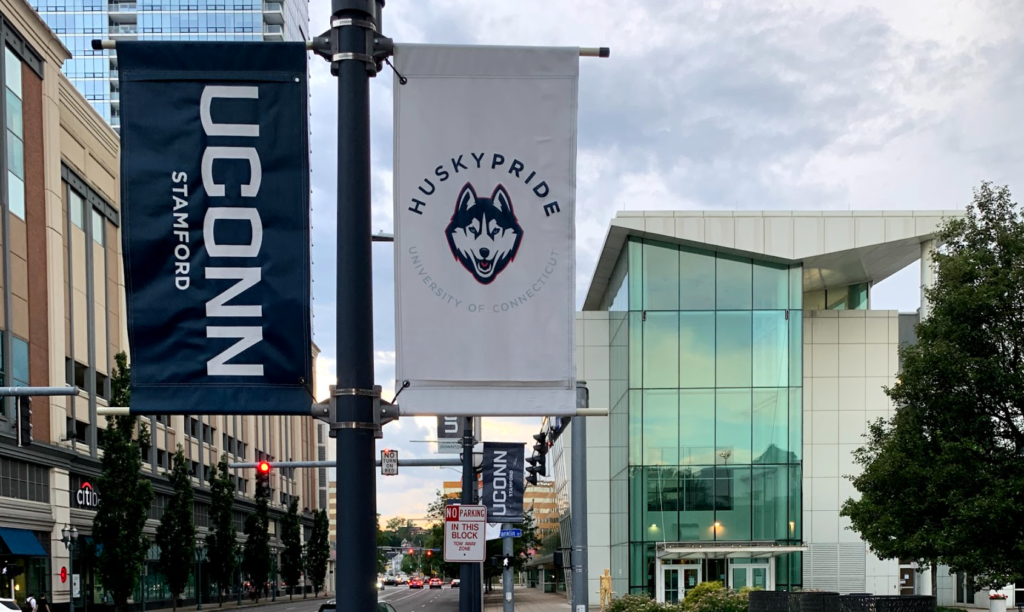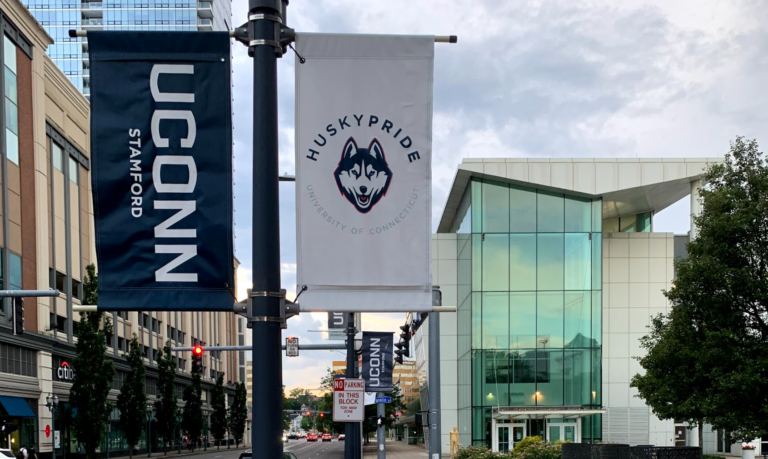The recent news about Netflix shooting movies in Stamford is a big story, but the bigger story is what happens after the Netflix crews pack up: More than 20 production companies shoot high quality television and films and other programming on location in Stamford. “Filmed in Stamford” happens every day because of digital media. Moreover, many of these productions enjoy an international audience.
Production companies come to Stamford to shoot on location because the city’s many and varied neighborhoods enable very different scenes to be shot in close proximity. And the city’s commitment to an efficient permitting process makes shooting in the city fast and hassle free.
“That means good-paying jobs for our city’s skilled workforce,” noted Thomas Madden, Director of Economic Development for the City of Stamford. “Digital media is the fastest growing creative industry, and Stamford is one of the most attractive cities to run a creative business that produces entertainment that the world wants to see.”
Four Reasons Why Stamford Attracts Digital Media
The digital media industry’s attraction to Stamford is more than cosmetic.
The New York City Studio Zone: A 30-mile radius from New York’s Columbus Circle that defines when actors and crew are responsible for traveling to and from a production set. Stamford’s west side is included in this zone.
According to the SAG’s Wrapbook Blog, when talent commutes to a set within the SAG Studio Zone, “their clock begins when they arrive [at the] set for hair and makeup. When they commute outside of a SAG Studio Zone, the clock starts the second they leave their residence.”
The difference between shooting inside and outside the Studio Zone determines how much money filmmakers save on production costs.
Concierge service: Stamford’s Department of Economic Development assures that production companies receive quick approvals for permits from the city.
“Production companies can be certain that they will receive approval within two days, as opposed to three or four months in New York and Atlanta,” Madden pointed out. “This certainty is a huge incentive for film crews on a tight schedule.”
Infrastructure: The Glenbrook satellite farm, as well as high speed fiber cables that were laid to support UBS and RBS trading floors, are essential utilities for digital production studios. For example, sports broadcasts from around the world are sent straight to Stamford, where NBC Sports repackages the content and sends it out to U.S. audiences with low latency. It’s why Olympics programming in the United States is produced in Stamford.
“We’re in constant communication to assure that fiber connections are upgraded and available throughout Stamford — and not just the main corridor,” Madden said.
Talent: Many of the creative people who work on movie and television productions in New York City actually live in Fairfield County. When the COVID-19 pandemic underscored the benefit of working in Stamford, people quickly appreciated getting back the two to three hours a day that they previously spent commuting. Moreover, Stamford’s lower cost of living and quick access to open space are added incentives that draw skilled people to the city.
Another factor is the talent pipeline coming out of area schools. “The Film Office has created job training efforts focused on digital media production,” said George Norfleet, Director, Office of Film, TV & Digital Media . “We launched Digital Media CT seven years ago. It’s a collaboration with several colleges and universities, including UCONN Stamford and other schools in Fairfield County, to prepare students for careers in digital media.”
Stamford Attracts Digital Media Producers
Beyond talent, crew, and other resources, a streamlined permitting process and generous tax credits make Stamford attractive to today’s new breed of digital producers. The Village, an industrial building reimagined as a campus for media businesses, is a recent example of businesses locating in Stamford.

Formerly a Canal Street warehouse, The Village is a creative coworking, office, meeting space with state-of the-art production facilities that includes nearly 1,000 feet of walkable marina.
“Digital drives everything in entertainment, including the creator economy,” said Brent Montgomery, CEO of Wheelhouse Entertainment, which he founded in 2018 with Jimmy Kimmel. “At Wheelhouse, we hope that Stamford and The Village will be right in the middle of it.”
 The 133,000 square-foot indoor-outdoor ‘work-play’ environment brings together best-in-class companies from the worlds of content and media, brands and marketing, social and experiential, as well as finance and investment. (Reserve your spot for a “sneak peek” at Cisco Brewers during the 2021 Memorial Day weekend.)
The 133,000 square-foot indoor-outdoor ‘work-play’ environment brings together best-in-class companies from the worlds of content and media, brands and marketing, social and experiential, as well as finance and investment. (Reserve your spot for a “sneak peek” at Cisco Brewers during the 2021 Memorial Day weekend.)
Montgomery and his wife Courtney (CEO of Wheelhouse Properties), developed this epicenter for creators and entrepreneurs as a catalyst for growth at Wheelhouse Entertainment.
“Wheelhouse produces high-profile content with leading talent, around which we create high-margin, ‘360 degree’ businesses. We believe social platforms are the new Mickey Mouse Club, where the next generation of stars will be hatched,” Montgomery explained. “At Wheelhouse, our goal is to ensure they have legacy through our entertainment ecosystem.
“Stamford’s digital media ecosystem makes our jobs easier, if not even possible,” he added.
 Wheelhouse has already helped some of the biggest young stars — such as the Hype House, Mark Rober and April Wilson — convert their short form talents into long form on streamers and traditional TV.
Wheelhouse has already helped some of the biggest young stars — such as the Hype House, Mark Rober and April Wilson — convert their short form talents into long form on streamers and traditional TV.
Filmed in Stamford: Five Tax Incentives
Madden’s job is made easier because Connecticut offers tax incentives to production companies like Netflix, CBS Interactive and Wheelhouse Media to film in the state, or locate production facilities here. Norfleet’s office serves as liaison between production companies, state agencies, municipalities, production facilities, local crews and vendors.
Combined with the studio zone, talent and infrastructure, Connecticut’s digital media and motion picture tax credit helps seal the deal. There are several programs available:
Digital Animation Production Company Tax Credit of 10 to 30 percent, based on the amount of qualified spending in Connecticut. This includes costs for development, preproduction, production or postproduction.
Digital Media and Motion Picture Tax Credit of up to 30 percent for production costs of at least $100,000. Producers can claim this tax credit if:
- At least 50 percent of principal photography days are conducted within the state;
- At least 50 percent of post production costs are spent within the state; or
- Producers spend $1 million or more in post production costs in Connecticut.
Film Infrastructure Tax Credit of 20 percent for facilities and other structures for production in Connecticut worth at least $3 million.
Film/TV/Digital Media Tax Exemptions on film, video and broadcast productions in Connecticut. The 12 percent hotel tax applies only to the first 30 days of occupancy. Purchases or leases of equipment to create audio or video productions may qualify for sales tax exemptions. Examples include motion picture and video equipment, sound recording equipment and equipment used to create master copies.
“A media executive once observed that Stamford is the Burbank of New York,” Madden recalled. “That’s high praise.”
Given the talent, resources and expertise located in Los Angeles, that’s more than high praise. His observation underscores Stamford’s enviable position as a lively city that is home to good jobs in a growth industry.
Move Your Business To Stamford
Since 1641, the nation’s best and brightest have called Stamford their home — and for good reason. A thriving business ecosystem, abundance of diverse urban and suburban living opportunities, and ample recreation and entertainment make Stamford a perfect place for production companies to call home.
If you want to learn more about Stamford opportunities for your production company contact Thomas Madden, AICP, Director, Economic Development and Executive Director, Urban Redevelopment Commission.
(203) 977-5168
tmadden@stamfordct.gov












 The 133,000 square-foot indoor-outdoor ‘work-play’ environment brings together best-in-class companies from the worlds of content and media, brands and marketing, social and experiential, as well as finance and investment. (
The 133,000 square-foot indoor-outdoor ‘work-play’ environment brings together best-in-class companies from the worlds of content and media, brands and marketing, social and experiential, as well as finance and investment. ( Wheelhouse has already helped some of the biggest young stars — such as the Hype House, Mark Rober and April Wilson — convert their short form talents into long form on streamers and traditional TV.
Wheelhouse has already helped some of the biggest young stars — such as the Hype House, Mark Rober and April Wilson — convert their short form talents into long form on streamers and traditional TV.
